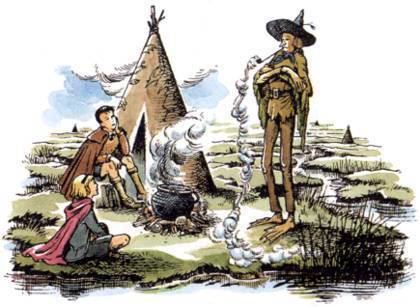Race Marsh-wiggle Affiliations Narnia Nation Narnia | Gender Male Species Marsh-wiggle | |
Similar Jill Pole, Rilian, Eustace Scrubb, Aravis, Lady of the Green Kirtle | ||
Narnia character study puddleglum
Puddleglum is a fictional character in the children's fantasy series The Chronicles of Narnia by C. S. Lewis. Puddleglum appears in The Silver Chair, in which he is a principal character. He also appears briefly at the end of The Last Battle. Puddleglum is an uncommonly cheerful marsh-wiggle; however, as marsh-wiggles are best known for their pessimism, he is still rather exceptionally gloomy, described by other characters as a "wet blanket".
Contents
- Narnia character study puddleglum
- Cgi puddleglum in narnia the silver chair
- Name
- Character development
- In The Silver Chair
- Christian elements
- Portrayals
- Additional reading
- References

Lewis said that his gardener Fred Paxford served as a model for Puddleglum.
Cgi puddleglum in narnia the silver chair
Name

The name Puddleglum may be a typical Marsh-wiggle name (no other Marsh-wiggle is named in the series), but it can also be viewed as a concatenation of "Puddle" for the wetland area where Marsh-wiggles live and "glum" which describes their outlook on life. It likely derives from the poet John Studley, whose comical choices of words Lewis criticized:
[Studley] uses more often than his fellows that diction which... cannot now be read without a smile – "frostyface", "topsy turvy", and (for Tacitae Stygis...) "Stygian puddle glum".The association is further strengthened by the fact that "Stygian" refers to the River Styx which was said to flow through the classical Underworld, and the three adventurers in The Silver Chair descend to the Narnian Underworld.
Character development
Nothing is known of Puddleglum's life before he appears in chapter 5 of The Silver Chair, where he first introduces himself by saying, "Puddleglum's my name. But it doesn't matter if you forget it." From then on, he is a caricature of pessimism and a bastion of gloomy fortitude: "I see you're making the best of a bad job. That's right. You've been well brought up, you have. You've learned to put a good face on things." But in the end Lewis gives readers a small sign that maybe spending time with Eustace and Jill has had an effect on him. After Jill surprises him with a farewell hug (and kiss), Puddleglum remarks, "Well, I wouldn't have dreamt of her doing that. Even though I am a good-looking chap."
In The Silver Chair
Puddleglum is the companion of Eustace and Jill as they search for Prince Rilian, heir to the Narnian throne, who disappeared 10 years earlier.
He is a unique character in Lewis's works. He is neither dashing nor charming, neither a great fighter nor a clever strategist. Yet he is instrumental in breaking the Emerald Witch's spell and releasing the Prince by stomping out her magical fire (badly injuring his foot in the process, though not as much as a normal human would, since his feet are webbed).
While the children initially (and not entirely without merit) consider him a "wet blanket" who removes the good from any situation, he proves to be a strong and steadfast companion, especially in Underland where he is all they have to cling to. It is Puddleglum who often spots the best course of action, and ultimately Puddleglum who wins the debate with the Lady, using an argument that incidentally reveals that he has overcome his cynical and pessimistic ways. She reacts furiously and turns into a serpent, only to be killed by Rilian, who finally realizes that she was the serpent who had killed his mother 10 years earlier. He then joins Rilian and the two children on their escape from the Underworld to Narnia.
Christian elements
Lewis, himself an expert on allegory, did not consider The Chronicles of Narnia allegory. He saw them as "suppositional" answering the question, "What might Christ become like, if there really were a world like Narnia and He chose to be incarnate and die and rise again in that world as He actually has done in ours?' This is not allegory at all." While not allegorical, Narnia does present significant parallels with elements from Christianity.
Lewis is perhaps using Puddleglum to give a somewhat existential statement of faith when he writes, "Suppose we have only dreamed, or made up, all of those things—trees and grass and sun and moon and stars and Aslan himself. Suppose we have. Then all I can say is that, in that case, the made-up things seem a good deal more important than the real ones... We're just babies making up a game, if you're right. But four babies playing a game can make a play-world which licks your real world hollow. That's why I'm going to stand by the playworld. I'm on Aslan's side even if there isn't any Aslan to lead it. I'm going to live as like a Narnian as I can even if there isn't any Narnia... and that's a small loss if the world's as dull as you say." Lewis himself said of this passage:
I suppose your philosopher son... means the chapter in which Puddleglum puts out the fire with his foot. He must thank Anselm and Descartes for it, not me. I have simply put the 'Ontological Proof' in a form suitable for children. And even that is not so remarkable a feat as you might think. You can get into children's heads a good deal which is quite beyond the Bishop of Woolwich.Lewis has, in sending the protagonists underground to a world which claims to be the only true one, also presented children with an inversion of Plato's allegory of the cave. Puddleglum, with Plato, recognizes the difference between the world of shadows, and the world with the sun.

